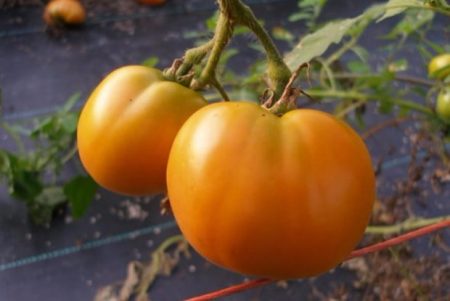
According to the characteristics and description of tomato variety Orange Giant, such a plant belongs to mid-season. Photos and reviews of summer residents confirm the rich productivity of the plant and allow us to judge its external data.
Tomato Orange giant (photo) can be grown both in the greenhouse and in the open ground. According to reviews of many gardeners, as well as relying on the characteristics and description of the variety, such a plant is highly resistant to dangerous diseases, tolerates temperature extremes and is not afraid of aridity.
Content
Characterization and description of the variety
The orange giant is a common, popular indeterminate tomato variety. In terms of ripening, it refers to mid-early species, from planting seedlings in the ground to the full ripening of the first fruits, about 100-115 days pass. Suitable for cultivation in unprotected soil, and in greenhouse conditions. It has increased immunity to major dangerous diseases and pests.
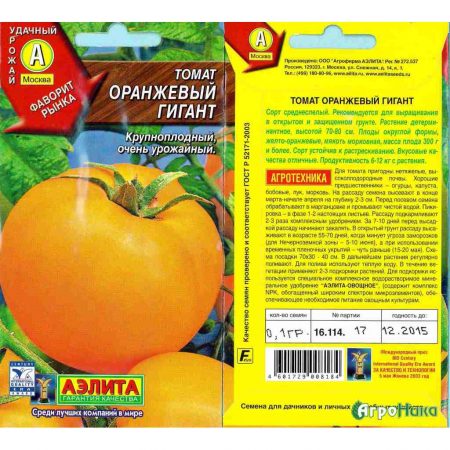
With good care from one bush, a tomato can get up to 3.5-5 kg of large, neat fruits. At the recommended planting density of 3 bushes per m2, you can collect up to 12-15 kg. This is a pretty good indicator for tomatoes.
Among the main features of this variety, the size and color of the fruits are most noted. It should also be noted that it is unpretentious in growing and resistant to frequent diseases. The plant responds well to dressing with mineral and organic compounds.
Tomato productivity Orange giant
Orange giant tomato is a popular, high-yielding vegetable. While ensuring proper care and observing the cultivation technique, from one bush a tomato manages to collect up to 5 kg of fruits, and from 1 m2 to 15 kg.
Advantages and disadvantages
The main advantages of tomato variety Orange Giant are:
- High commercial properties.
- Rich yield.
- Excellent taste.
- Large fruit size.
- Resistance of a plant to many dangerous diseases.
- Variety tomato Orange giant is not afraid of temperature changes and tolerates not long drought.
Among the shortcomings of the plant, the weakness of the stems and the high demands of the crop for the application of mineral and organic fertilizers are distinguished.
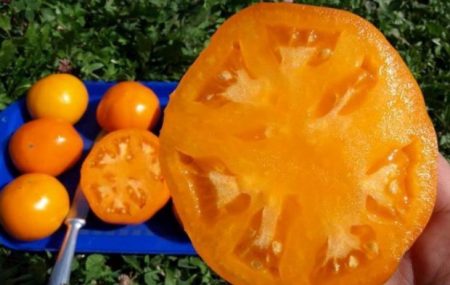
The purpose of the vegetable
Due to its large size and excellent taste, Orange giant tomatoes are widely used for preparing various dishes, salads, juice and fresh consumption.
Such tomato fruits are not suitable for pickling, since their mass is large. But tomatoes can be pickled in wooden barrels, the taste is no worse than with a pickle.
Growing rules
Growing tomato varieties Orange giant is carried out by planting seedlings. Such tomatoes can be planted both in the greenhouse and in the open ground. When forming a bush, it is better to take 2-3 seedlings, because the stems of the plant are weak and do not withstand large fruits.
As for the soil, areas with sandy loam and loamy soil are selected that contain the optimum pH.
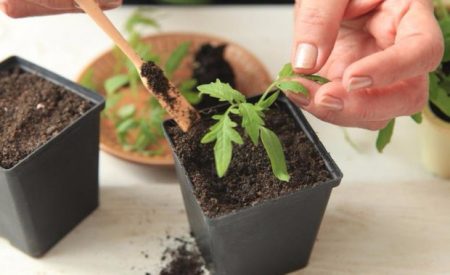
Growing tomato varieties Orange giant, carried out in 3 stages:
Soil preparation - carried out since the fall. At this stage, they carry out the loosening of the earth, make the necessary mineral and organic fertilizers, get rid of weeds.When choosing a site where seedlings will be planted, preference should be given to those where last year onions, zucchini or cabbage grew. On the contrary, places for growing potatoes and nightshade crops should be excluded.
Planting seeds - carried out in the spring, namely in late April or early March. Planting is carried out in special containers or boxes that should have small openings on the bottom so that ventilation is carried out and the plants receive the fresh air they need.
Seeds are planted in a special substrate, which is prepared previously. It includes components such as peat, superphosphate, sawdust, ash and greenhouse soil. Sawdust is pre-soaked in boiling water and steamed with ammonium nitrate.
Planting tomato seeds is carried out in the traditional way. First, they make small furrows, plant seeds, fill them with soil from above and pour water at room temperature.
Planting seedlings in open ground or a greenhouse - is carried out after the tomato seedlings are finally formed and strengthened. Before planting, the soil is prepared, it is dug up, shallow holes are dug around the entire perimeter of the plot with an interval of 30 cm between plants, and between rows of 50 cm.After moisten, plant seedlings, immersing it halfway into the ground, and sprinkle with dry soil on top.
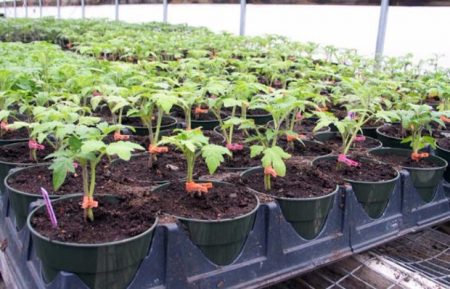
The final stage of planting is considered a thorough watering of the holes. On one bush, it is recommended to use up to a liter of water.
Care Rules
Care for tomato varieties Orange giant is carried out immediately after planting seeds. But the main events are held when seedlings are planted in open soil or a greenhouse. At this stage, regularly, if necessary, weeding, hilling the earth, watering plants, shredding bushes, tying, and also carry out the fight against diseases and pests.
Watering is carried out as the soil dries, since excess moisture can lead to dangerous diseases. Bushes are watered more intensively during their flowering and fruit setting. Then the demand for fluid can reach up to 1 liter per well. During the rainy season, abundant watering excludes or does not water the planting at all.
Top dressing is carried out 3 or more times during the growth of tomatoes. Since this variety is more responsive to fertilizers and responds to better development and the rapid formation of fruits. Organic and mineral fertilizers are used for top dressing. It can be superphosphate, humus, wood ash, potassium compounds, ammonium nitrate and other means.
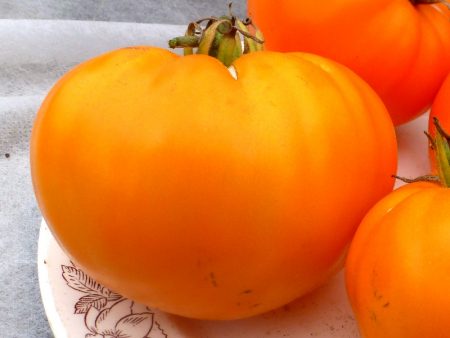
Chop tomato plants as needed. In the process of this method of care, they cut off excess leaves and stems, leaving one, more powerful, on which there are ovaries of tomatoes.
Weeding and hilling of landings is carried out, as a rule, in parallel with watering.
They fight diseases and pests both by folk methods and use special chemicals.
Diseases and Pests
Most of the gardeners and gardeners noted that the Orange giant tomatoes are highly resistant to certain diseases. However, some pathological processes in tomatoes still occur, but they, as a rule, are associated with a shortage of planting care skills.
To avoid such diseases, it is necessary to properly organize care, when growing a tomato in a greenhouse, maintain the desired temperature, humidity and lighting.
Common pests of any tomato varieties are aphids, bears, wireworms and whiteflies. They are fought with special means, which are sprayed around the perimeter of the plant.

Reviews
Valery, 58 years old
“For the past 4 years, I have been planting tomato varieties Orange giant. I really like this kind of vegetable, it’s easy to grow, with the timely application of fertilizers the fruits develop quickly and grow up to 500 g. ”
Elizabeth, 35 years old
“I liked the orange giant tomatoes. Planted them for the first time in the greenhouse, the yield was good. The fruits were fleshy, juicy with a pleasant sweet taste. Now I’ve planted tomatoes in open ground, I’ll see what happens. ”
Taisiya, 46 years old
“I have long dreamed of planting tomatoes with large fruits in the country, but still I couldn’t succeed. And last summer, my friend advised me to buy the seeds of the Orange giant, which has been planting for more than 3 years. And so I planted, I liked the tomatoes very much, they are all large, the skin is smooth with an even pink color and the taste is just wonderful. ”




 Low-growing tomatoes, without pinching: 5 of the most delicious varieties
Low-growing tomatoes, without pinching: 5 of the most delicious varieties Why tomato seedlings grow poorly
Why tomato seedlings grow poorly We grow a tomato in a shell
We grow a tomato in a shell Growing tomatoes without watering according to the method of Kazarin
Growing tomatoes without watering according to the method of Kazarin